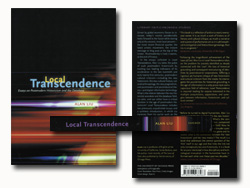| 2008 |
Local Transcendence: Essays on Postmodern Historicism and the DatabaseCategories Books , Publications Books , Publications
|

|
Citation: Local Transcendence: Essays on Postmodern Historicism and the Database. Chicago: University of Chicago Press, 2008.
[392 pp., ISBN-10: 0226486966, ISBN-13: 978-0226486963] |
Book of essays on the methodology of the new historicism and other modes of postmodern cultural criticism in the age of the network and the database (Chicago: University of Chicago Press, 2008)
In 1983, he lined the walls of a room with floor-to-ceiling panels of cardboard on which he carefully inscribed the events of William Wordsworth’s life and times until he was encircled by an intricate, seething web of dates threaded with colored strings pinned from node to node. Sometimes when he stood back, he could almost make out the whole pattern there. Something immanent–not the portrait of an author or his age, perhaps, yet more than just a pulsing circuitry of convergences and divergences–seemed to bulge across the interface into the room. But it always retreated. There was too much imprecision, white space, noise in the panels–too much that could not be known or inscribed except through imprecision, white space, noise.
In 1989, he wrote an essay on the fascination of postmodern cultural criticism with “local knowledge,” “the massive fact of cultural and historical particularity,” “the concrete, the material, and the particular,” “the details of disposition and empirical contingency,” the “picture of great detail,” “etc.” “Media-oriented readers,” he wrote, “may wish to view this matrix [of detail] as if with remote control in hand–flitting from channel to channel and sentence fragment to fragment in a hallucinatory blur of strangely continuous discontinuity.” Perhaps detailism, he thought, could be immersion in history. But in the end, he found himself again writing about the retreat of the presence. Immanence became detachment. The pictures of great detail dissolved into simulations whose hyper-resolution was somehow the same as background noise, a mere texture or decor of history.
Then in the 1990s, he thought he had found the medium of capable imagination for these slippery encounters with history: not cardboard or TV channel, but network and database. Some years after collaborating to build the Romantic Chronology on the Web, he rebuilt the site in a database that dynamically generated lists of events, each flanked by a “Details” link that convened related resources automatically. As in the case of other database-to-Web projects he experimented with at the time (culminating in the migration of his Voice of the Shuttle into a database), he felt that the Romantic Chronology might thus offer a fuller, livelier picture of great detail. Yet, the more he learned about the workings of databases, the more he woke to the fact that the great, digitally-sharp massifs of detail they rendered only set off by contrast all the presence not there–whatever could not be cut up and cut down to fit the granular structures of databases, whatever could thus appear only as a ghost within the ceaseless froth of redundant or contradictory entries, overlapping dates, null values, and other database noise attesting to the pressure of the unstructured and unknown. That part of history that was by nature blurred, messy, and contingent (contingent-em, Latin for “touching together or on all sides, lying near, contiguous, coming into contact or connexion, befalling, happening, coming to pass”; from con + tangere, con-touch) could not manifest in databases of fine, digital touch. Only some grosser, whole-body, ambient touch, he thought, could make contact with the ghost.
This final essay in the volume speculates at once retrospectively and prospectively on the function of the New Historicism in the age of the database. In the New Historicism and other postmodern cultural criticisms, history at once emerges from the buzzing, blooming swarm of events caught in the great matrix of detail, and escapes in the noise of that detail. Similarly, history both manifests and sublimes in databases, both emerges in the tables, records, fields, and joins that are the structure of the modern relational database (implemented in SQL, or Structured Query Language) and escapes all such holding structures. Whether in the form of the New Historicism or of a database, contemporary postmodern historicism is an escape structure. As they say, it is the “end of history.”
Yet the New Historicism does not just accompany data on the great escape of random access. Its specific function in the age of the database, I believe, is to bind that escape to the escape structures of the past that might be called the beginning of the end of history.
I start with a note–no more than an anecdote–recounted by Charles Babbage; go on to consider the relational database (epitomized in a recent database project at the Microsoft research labs); and conclude by reflecting, once again, on the New Historicism. . . .
